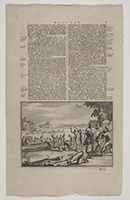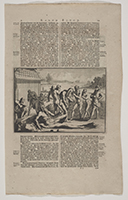"Forms of Saints or Vagabonds
Copperplate engraving on paper
From a Dutch copy of Pieter van der Aa (1659-1733), Voyagien der Engelsen (Voyages of the English) (Leyden: P. van der Aa, 1706).
Robert J. Del Bontà collection, E1150


In the early 1700s, the prolific Dutch publisher Pieter van der Aa compiled travel accounts from the previous three centuries into multivolume sets that documented the world with the aid of engraved maps and illustrations. These two prints, which faced each other in the book, are from a section devoted to the voyages of the English, or Voyagien der Engelsen. They specifically illustrate the Dutch translation of Journey to India over-land by the British merchant Ralph Fitch, published in 1583. Fitch interpreted the scenes in the left-hand print as "strange ceremonies," such as Indian pilgrims bathing in the river Ganges and performing "penance" through "prostrations" to the sun and earth. The right-hand print actually shows Fitch observing an ascetic "who never spake," likely having taken a vow of silence. Though naming him a "monster among the rest" of the "beggars," Fitch intimately detailed the ascetic's figure, describing him as having "hair... so long and plentiful, that it covered his nakedness" and "nails... two inches long, as he would cut nothing from him."